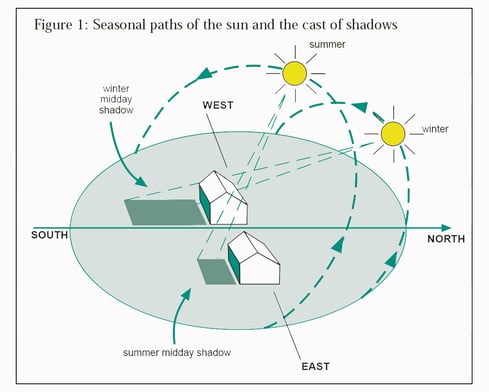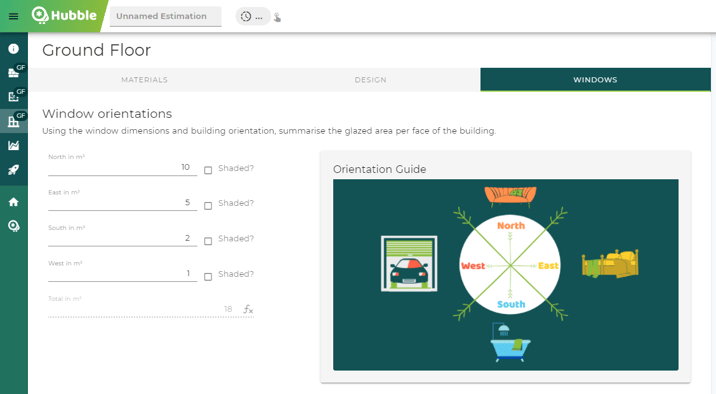Having a home with good orientation allows for cheaper and more comfortable living as well as increased energy efficiency. The direction your house and windows face and their solar access is one of the most important aspects to consider.
The strategy for solar access and window orientation/placement is climate-dependent. For instance, in a hot humid, or hot dry climate with no winter heating requirements (such as Darwin, NT), orientation should aim to make the most of cool breezes whilst excluding the sun for the entire year. In the majority of other climates, a combination of passive solar heating and passive cooling is generally required.
The ideal house orientation is one that aligns with an East-West axis, i.e. the longer sides of the house are facing North and South, minimising the wall area that receives hot morning and afternoon sun. As Image 1 (below) demonstrates, the amount of sunlight directed at a window varies according to the time of year, orientation and obstructions. In the Southern Hemisphere, the angle of the sun makes a high arc across the sky in summer and a low arc in winter.

Image source: https://www.ecodesignadvisor.org.nz/wp-content/uploads/2018/01/julie-Solar-2.jpg
North-facing windows
North facing windows receive the highest amount of sunlight - and the most heat - all year round. This means that in a climate like Adelaide, the passive heating strategy would be to maximise the amount of sunlight and heat being let into the home in winter and eliminate it in summer.
If your house does not have North-facing living areas, consider high-level openable windows that can capture the winter sun and create cooling currents in summer.
East & West-facing windows
It is recommended to keep east and west-facing windows small and well-shaded, particularly those facing west. This is because they receive minimal sunlight in winter, and excessive sunlight in summer. Alternatively, you should consider using high-performance glazing on these orientations.
South-facing windows
Windows on the South of a building do not receive any sunlight during winter and only early morning and late afternoon sunlight in summer. Oftentimes, this means that heat from within the home will be lost from South-facing windows. It is recommended to keep south windows smaller, however, they provide excellent natural ventilation by making the most of cooling summer breezes. Double glazing can stop around 35% of heat loss in Summer and is recommended for South-facing glazing.
Window percentages & Hubble orientation guide
For best results, the total window area should be less than 25% of the total floor area of your home. Considering the information we have covered in this article, Hubble suggests following this ideal room placement/orientation guide if possible.
-
-
- Living areas to the North
Aim for 60% window area to wall area
- Bedrooms to the East
Aim for 30% window area to wall area
- Bathrooms to the South
Aim for 15% window area to wall area
- Garage or carports on the West
Aim for 0-7% window area to wall area

Hubble helps you to understand the effect of window placement on the performance of your home. Simply enter the window area (m²) for each orientation and alter as necessary. Our platform can help you find the right balance for your windows!
Join the Hubble waitlist now!
Sources
https://build.com.au/window-orientation-and-placement
https://www.abc.net.au/tv/carboncops/factsheets/cc_windows.pdf
https://www.yourhome.gov.au/passive-design/orientation
https://www.sa.gov.au/topics/energy-and-environment/energy-efficient-home-design/windows-and-shading